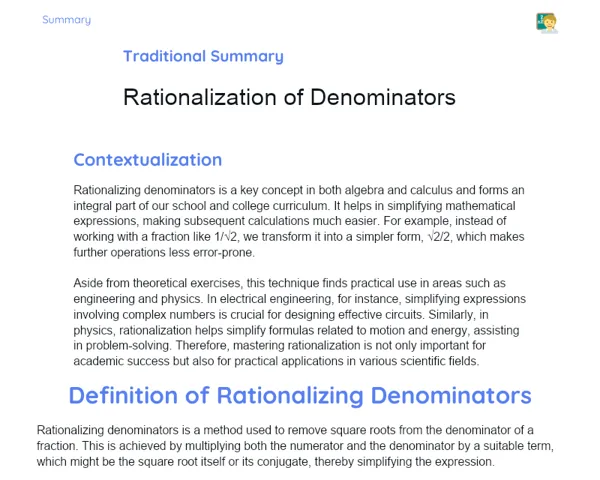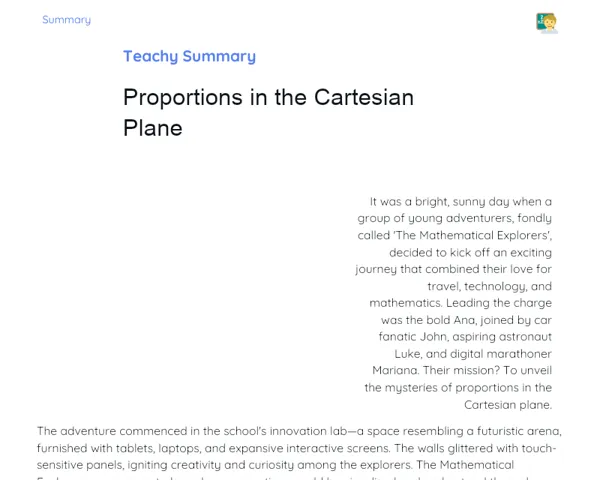Summary Tradisional | Proportionality Relationships
Contextualization
In our daily lives, we often encounter situations involving proportional relationships, where one quantity adjusts in a predictable manner relative to another. A good example is in cooking – if a recipe originally meant for four people calls for 200 g of flour, we would need to double that to 400 g to serve eight guests. This straightforward adjustment is a practical illustration of how we apply proportionality every day.
Another familiar scenario is the constant speed of a vehicle during a journey. The connection between the distance covered and the time taken is a classic example of proportionality. For instance, if a car drives steadily at 60 km/h, it will travel 60 km in one hour, 120 km in two hours, and so forth. This relationship between distance and time is key to understanding and calculating speed. These examples from everyday life provide a solid grounding in the concept of proportionality and its varied applications.
To Remember!
Definition of Proportionality
Proportionality refers to a mathematical relationship where two quantities change consistently in relation to each other. This means that if one quantity rises or falls, the other does too, in a fixed ratio. This relationship is depicted through a constant of proportionality.
For a clearer understanding, think of adjusting a recipe that serves four people and requires 200 g of flour. To make it for eight people, you would simply need to double the flour to 400 g. This direct link between the number of servings and the amount of flour is a fundamental example of proportionality.
Proportionality is often represented in the form of ratios, like 1:2, 2:3, or 4:5. These ratios illustrate how one quantity relates to another consistently. For instance, if the ratio of flour to people is 1:4, it indicates that for each additional person, you require one-fourth of the flour needed for four people.
-
Proportionality indicates a consistent relationship between two quantities.
-
It is represented by a constant of proportionality.
-
It can be expressed as a fraction or ratio.
Constant of Proportionality
The constant of proportionality is the fixed value that one quantity must be multiplied by to derive another related quantity. This constant is integral to proportional relationships and is commonly denoted by 'k'.
To find this constant, we can use the formula k = y/x, where 'y' is the dependent quantity and 'x' is the independent quantity. For example, if there is a proportional relationship between distance (d) and time (t), the constant of proportionality would be k = d/t, equivalent to constant speed.
It’s crucial to remember that the constant of proportionality remains the same across all pairs of related quantities. If it changes, then the quantities aren’t proportional anymore. Grasping this concept is vital for tackling real-world problems in areas like calculating average speed or scaling cooking recipes.
-
The constant of proportionality relates two proportional quantities with a fixed value.
-
It is represented by 'k'.
-
Calculated using the formula k = y/x.
Practical Examples
Practical examples help solidify our grasp of proportional relationships by demonstrating their use in real-life contexts. A classic case is the interplay between speed, distance, and time. While traveling by car, if the speed is consistent, the distance covered is directly proportional to the time taken. So, if a car moves at 60 km/h, it will traverse 120 km in 2 hours.
Cooking also provides a relatable example. If a recipe serving 4 people needs 200 g of flour, you’ll need 400 g if you decide to cook for 8. This proportional adjustment is crucial for modifying recipes based on the number of servings needed.
Furthermore, engineering frequently employs proportionality to guarantee safety and efficiency in construction. Take bridge design, for instance; engineers must calculate proportions to ensure the structure can bear applied weight and forces. Such proportional evaluations are foundational to robust engineering.
-
Practical examples enhance understanding of proportional relationships.
-
Speed, distance, and time illustrate a classic relationship.
-
Proportionality also plays a key role in cooking and engineering.
Problem Solving
To tackle problems involving proportionality, a firm grasp of ratios and the constant of proportionality is essential. Generally, you begin by identifying the relevant quantities, calculate the constant of proportionality, and leverage that constant to resolve the issue at hand.
For instance, if five apples cost ₹10.00, you could find out how much eight apples would cost while keeping the same proportion. First, determine the cost per apple (₹10.00/5 apples = ₹2.00 per apple). Then, multiply this unit cost by the desired number of apples: 8 apples * ₹2.00/apple = ₹16.00.
Another example could involve calculating the constant speed of a car. If the car covers 150 km in 3 hours, the speed would be determined by dividing the distance by the time: v = 150 km / 3 h = 50 km/h. Such problems are commonplace and reinforce the practical use of proportionality.
-
Solving proportionality problems necessitates calculating the constant of proportionality.
-
Identify the quantities and apply the constant to solve the problem.
-
Examples include determining proportional costs and constant speeds.
Key Terms
-
Proportionality: Consistent relationship between two quantities.
-
Constant of Proportionality: Fixed value relating two proportional quantities, represented by 'k'.
-
Ratio: Representation of the relationship between two quantities in fraction format.
-
Speed: Proportional relationship between distance and time, calculated as v = d/t.
-
Distance: Measure of space traveled.
-
Time: Duration during which an event occurs.
-
Practical Examples: Real-world situations illustrating proportional relationships.
-
Problem Solving: Application of proportionality concepts to resolve practical issues.
Important Conclusions
In today's lesson, we covered the definition of proportionality and its manifestations in our everyday lives. We learned that two quantities are proportional when their ratio remains constant, expressed through the constant of proportionality (k). Real-life examples, such as a vehicle's constant speed and adjustments in recipes, served to demonstrate the concept effectively.
The constant of proportionality is a fixed value relating two proportional quantities and can be calculated via the formula k = y/x. This understanding is fundamental for addressing practical challenges, whether it's calculating a vehicle's average speed or determining the proportional cost of items. Familiarizing ourselves with these concepts opens the door to applying proportionality across various fields, from engineering to cooking, fostering efficiency and safety in practice.
The significance of this topic is clear, as proportionality is prevalent in a multitude of everyday scenarios. Understanding these relationships empowers us to tackle problems adeptly and make informed decisions. I encourage you to delve deeper into this topic, exploring other scenarios where proportionality plays a role. This will promote ongoing and meaningful learning.
Study Tips
-
Review the practical examples we discussed and try applying proportionality concepts in other scenarios.
-
Practice solving proportionality problems across diverse contexts like cooking, speed, and engineering.
-
Examine the relationship between quantities and the constant of proportionality, seeking to grasp how k = y/x functions across various types of problems.



